
14 Jul Genealogist- Newsletter- July 13, 2024
Contents
- 1 MOTORING ON MICHIGAN HIGHWAY 185 IS IMPOSSIBLE
- 2 A GENEALOGIST VISITED THE SUN PARLOUR OF CANADA
- 3 AS GENEALOGISTS WOULD SAY “THE FATHER OF THE FATHER OF TEXAS”, LEAD KING, AND BUSINESS FAILURE
- 4 THE NOT SO NATIVE AMERICANS
- 5 GENEALOGISTS EXPLORE CONFEDERATES ON THE GREAT LAKES
- 6 WHAT ABOUT YOUR DESCENDANTS KNOWING ABOUT YOUR ANCESTORS?
 MOTORING ON MICHIGAN HIGHWAY 185 IS IMPOSSIBLE
MOTORING ON MICHIGAN HIGHWAY 185 IS IMPOSSIBLE
Out of more than 4 million miles of public streets in the United States, there’s an 8.2-mile stretch of road on Mackinac Island that stands apart. M-185 is the only state highway in the country where motor vehicles are not allowed.
Instead, the traffic on Mackinac Island consists of pedestrians, bicyclists and horse-drawn carriages.
Horses first arrived on Mackinac Island around 1780 when the British used them to haul parts of Fort Michilimackinac from the mainland near present-day Mackinaw City over the ice to the island.
By the mid-1800s, Mackinac Island was evolving into a tourist destination and tours by horse carriage became a popular way to see the incredible sights. The first carriage license was issued in 1869.
But it could have turned out much differently had Mackinac Island not taken steps to ban “horseless carriages” more than 125 years ago.
While visitors can’t take a car to Mackinac Island, some exceptions have been made over the years. For one, a few vehicles were allowed on Mackinac Island for the filming of the 1979 movie “Somewhere in Time” starring Christopher Reeve and Jane Seymour. Also, the utility company that provides electricity to Mackinac Island has trucks on the island, and emergency vehicles are on the island all the time to protect the health and safety of Mackinac Island residents and visitors. In fact, the first and only auto accident occurred in 2005 when a fire truck utility door was damaged by clipping the open door of an ambulance. Genealogist.
In addition to emergency vehicles, the golf courses on Mackinac Island allow golf carts. And many of Mackinac Island’s year-round residents use snowmobiles to get around in the winter. As for deliveries on Mackinac Island, however, there are no mail trucks or UPS trucks. Deliveries are made by horse-drawn dray.
There are 600 horses, all stabled in a large barn. 400 of them are used for pulling carriages, and 200 of them for dray service. You see pooper-scoopers all over the place cleaning up from the horses. So, as a Genealogist asked the obvious question. With 600 horses on a small island with premium real estate, where do you put all of the poop. The answer was interesting. They mix the poop up with leftover food scraps from the many restaurants, turn it into manure, and it is sold and shipped to the mainland.

 A GENEALOGIST VISITED THE SUN PARLOUR OF CANADA
A GENEALOGIST VISITED THE SUN PARLOUR OF CANADA
The history of wine manufacturing in the Great Lakes region began with experimentation on the Ohio River. Within a few decades, grapes were relocated to the islands of Lake Erie. Within Ontario, wine had been made since the time of the French explorer Robert de La Salle (1643-1687), who made wine from local grapes while camping on the shores of the Detroit River. It was also known that the Jesuits made wine, and the French settled along the Detroit River as early as the mid-1700s.
Pelee Island, the southernmost inhabited place in Canada, has a more extended growing season than the nearby mainland of Canada. There are lots of fruits and vegetables, and even cannabis grown along the Ontario lakeshore north of Pelee Island.
Like any early settlement, the first grape grower and early settlers to Pelee Island faced many challenges. Clearing the land, building houses, cultivating the soil, and planting crops are laborious and challenging at the best of times, but living on an Island brings a whole new set of unique challenges. Thaddeus Smith writes, “To come here and live was like being a pioneer in a wilderness, away from most of the advantages of civilization, and to endure many hardships and privations”. The nature of a community can often be better told in what is not there rather than what is. As an Island, the apparent absence was transportation. The prevention of early settlers from coming to the Island was on how even to get there.
“There was no steamboat running to the island and no regular line of sailboats, which made it difficult for strangers to reach here. The only way the inhabitants could get off the island and onto it was in their own private sail or row boats, and any stranger wishing to get to the island would have to take their chances and come by some of these boats.”
The first grape grower on Pelee Island was Henry Price. It was in 1854 that he planted a small vineyard, but because he did not have a clear title to the land, he was forced to abandon his endeavor. The Letters of Patent, allowing for the proper sale and transfer of land title, was granted on July 29th, 1867. The stage was set for the settlement of the Island. Now, the early grape growers had proper holdings of their land. Genealogist.
To market their grapes and wine, Thaddeus and the Wardroper brothers had to travel to the mainland to try and find markets and buyers. Thaddeus hired J.S. Hamilton, Dunlop, and Company as his representative; other buyers were found through them.
“In 1877, a few years after the first wine was made on the Island, sales were sought in the fresh fruit market. Large quantities of grapes were shipped to fruit dealers in London, Hamilton, and Toronto. In addition, in November of the same year, Smith, Williams, and Company shipped 250 gallons of their native wine to a number of smaller customers on the steamer Lake Breeze. In the spring of 1878, Thaddeus Smith’s remaining stock of wine, pressed from Catawba, Isabella, and other varieties of grapes, was removed to the warehouse of Hamilton, Dunlop, and Company in Brantford.”
At a Town Hall meeting on January 8th, 1879, a resolution was passed to address the problem of poor communication on the Island. A petition to establish a post office on the Island was sent to the Postmaster General and Members of Parliament. The petition was granted, and A.M. McCormick became the first Postmaster of Pelee Island. The Post office was established out of his store at the West Dock. The benefit of having a post office and communication to better market their wines was felt immediately. Pelee Island wines have continued to thrive ever since.
Above is a picture of the Vin Villa Winery on Pelee Island, and below are some earlier tourists at another Pelee Island winery.

 AS GENEALOGISTS WOULD SAY “THE FATHER OF THE FATHER OF TEXAS”, LEAD KING, AND BUSINESS FAILURE
AS GENEALOGISTS WOULD SAY “THE FATHER OF THE FATHER OF TEXAS”, LEAD KING, AND BUSINESS FAILURE
In 1784, Moses Austin moved to Philadelphia to enter the dry goods business with his brother, Stephen. He then moved to Richmond, Virginia, to open a second dry goods store. In 1785, he married Mary Brown from an affluent iron mining family. The Austins’ second child was born in 1793 and named Stephen Fuller Austin in honor of his father’s brother and his mother’s great-uncle. Their daughter Emily Austin followed in 1795. A second son, James Elijah Brown Austin, was born in 1803.
Austin sought to start his own mining business in southwestern Virginia, and in 1789, he traveled there to look at a lead mine. Moses saw potential in the site, and by 1791, his family had joined him in what is now Wythe County. Moses and his brother Stephen, as well as several other partners and individuals, industrialized the area. Several smelters, furnaces, commissaries, blacksmith shops, liveries, and mills were established. The tiny village around the mines became known as “Austinville”, and Moses became known as the “Lead King”.
The Austin brothers soon incurred debts, causing the collapse of the company. After the Virginia-based lead business failed, Moses skipped out to avoid imprisonment and the consequences of debt, which was customary for debtors in the U.S., and looked toward the rich lead deposits in Missouri, then a part of upper Spanish Louisiana. In December 1797, Austin and a companion traveled to investigate the Spanish mines. Stephen remained behind to salvage the Virginia business, creating a rift between the two brothers that would last much of their lives. Virginia seized much of Moses’s property and broke up the various operations.
In 1798, the Spanish colonial government granted Moses one league of land (4,428 acres) for lead mining operations. In return, he swore allegiance to the Spanish Crown and stated he would settle some families in Missouri. Traveling to Missouri, Austin worked with Francois Valle to identify his claims and to learn the practices of lead mining in Missouri.
Valle and other French colonizers had long used enslaved African Americans and enslaved Native Americans to mine, and Austin immediately took to these practices. In 1798, the year of his arrival in Missouri, he purchased at least one enslaved man. Moses greatly expanded the use of enslaved men and women in running mining operations in Missouri. Enslaved African American men were used for the complex, difficult labor of digging and processing the lead ore. Enslaved boys were forced to man the carts that carried ore from the pits to the smelters. Enslaved women and girls were used to prepare food for the enslaved men who worked the mines, pits, and smelting operations.
In 1803, Missouri came under the jurisdiction of the United States as part of the Louisiana Purchase. Austin became the founder and principal stockholder in the Bank of St. Louis, but the bank failed in the Panic of 1819, causing him to lose his entire fortune. He again sought help from Spain. In 1820, Austin traveled to the Presidio San Antonio de Béxar in Spanish Texas and presented a plan to colonize Texas with Anglo-Americans to Governor Antonio María Martínez.
In 1821, the governor asked Austin’s friend, Erasmo Seguín, to inform him that he had been awarded a land grant and permission to settle three hundred families in Texas. On Austin’s return trip, he became ill with pneumonia, and he died in June 1821, shortly after arriving back in Missouri. His son Stephen F. Austin carried out his colonization plan several years later, leading the three hundred families to the first Anglo-American settlement in Texas.
 THE NOT SO NATIVE AMERICANS
THE NOT SO NATIVE AMERICANS
Genealogists often get inquiries from folks who have grown up hearing of their Native American ancestry and tell stories of great-grandparents dressing up as Indians and even visiting the reservation.
When we checked their DNA, we saw no Native American DNA. So, how do you explain the discrepancy? Here are some possibilities:
The Improved Order of Red Men is a fraternal organization established in North America in 1834. It claims direct descent from the colonial era Sons of Liberty. Their rituals and regalia are modeled after those assumed by men of the era to be used by Native Americans.
Despite the name, the order was formed solely by and for white men. This whites-only rule was part of their bylaws until 1974 when the all-white clause was eliminated. Their current position is that they are now open to people of all ethnic backgrounds. In 1935, the organization claimed a membership of about half a million, but it has now declined to a little more than 15,000. Notable members included Presidents Warren G. Harding, Theodore, and Franklin D. Roosevelt. Genealogist.
The Degree of Pocahontas is the female auxiliary of the Improved Order of Red Men, an American fraternal order. Despite using names based on common non-Native ideas about Native Americans, it was formed solely by and for white women (below).

 GENEALOGISTS EXPLORE CONFEDERATES ON THE GREAT LAKES
GENEALOGISTS EXPLORE CONFEDERATES ON THE GREAT LAKES
Our last edition covered the Mystery of the Silver Teapot and Jacob Thompson as the probable acquirer of the teapot. Here’s a bit more about Jacob Thompson:
Jefferson Davis and Judah chose Jacob Thompson to lead the Confederate spy effort in Canada. Thompson had a fine pedigree in politics, having served as a congressman and secretary of the interior under President James Buchanan. Being from Mississippi, Thompson had no love for the Union and accepted the job immediately. Thompson was to serve as the head of the Confederacy’s underground movement in Canada and had the final say in what operations he wanted to conduct and the people he would hire.
Using Canada as his base of operations, Thompson was directed to wreak havoc on Union targets and disrupt the Federal war effort. He was to use his assets to attack Union military facilities in the Northwestern states and foment rebellion. Davis said if these efforts were successful, then Abraham Lincoln would have no choice but to sue for peace on Richmond’s terms. Davis gave Thompson a draft for $l million in gold to finance the operation and told him to “carry out such instructions as you have received from me verbally.”
Colonel Thompson was a man of sterling integrity, but he was inclined to believe too much that was told to him, to trust too many men, to doubt too little, and to suspect less. His subordinates were continually apprehensive lest he compromise their efforts by indiscreet confidences.
One of their plots involved a transplanted Kentucky physician named Luke Blackburn, who had gone to Canada at the behest of Mississippi Governor John J. Pettus to oversee relief supplies arriving aboard blockade runners from England. Blackburn, a relative of Kentucky Senator Henry Clay, had helped fight yellow fever outbreaks in the South and, most recently, in Bermuda.
According to testimony revealed in his subsequent trial, Blackburn put that experience to work less benignly, attempting to spread the dread disease among the military and civilian populations of the North. He supposedly sent clothing believed to be infected with yellow fever to Abraham Lincoln as a gift. He did not want to deliver the package himself and asked that a friend deliver it for him. At the last minute, the man refused to make the delivery. At the time, it was believed that yellow fever was spread by human contact, although mosquitoes actually spread it. Genealogist.
Another operation was carried out in Canada with Thompson’s cooperation. The plan called for the capture of the steamer USS Michigan, which was operating on Lake Erie, and use it to free the estimated 2,700 Confederate prisoners held in a Union prison camp at Johnson’s Island in Sandusky, Ohio. The escaped prisoners would then band together as a foraging army and fight back across the state to Virginia. At the same time, the Rebel-controlled Michigan would move down the lake, bombarding Detroit, Cleveland, Buffalo, and Sandusky, Ohio.
Thompson asked John Yates Beall (pictured above), a well-known Confederate sailor named “Mosby of the Chesapeake,” to head the operation because of his successful exploits against Union shipping on that river. On September 19, Beall destroyed four Union schooners. Elaborate plans had been set up to carry out the raid. Beall and 20 men boarded the ship Philo Parsons, which ran on the Detroit-Sandusky route. Beall asked the skipper to make an unscheduled stop at Amherstburg on the Canadian side of the border, where he picked up more men. Genealogist.
As the ship approached Johnson’s Island, Beall took over the vessel and hoisted the Confederate flag. He let the passengers out before heading for his destination. Captain Charles Cole of the Confederate Army was to signal from shore that it was all clear to attack the fort. However, Cole was arrested by Federal authorities. It was later speculated that Cole had been betrayed by a Confederate captive held aboard Michigan. With no signal, Beall broke off the strike and returned to Canada. Cole was taken to Fort Lafayette in New York harbor, where he was tried and convicted of spying for the Confederacy. A full confession earned him amnesty, and Cole was released in the spring of 1865.
Beall’s next assignment was to intercept a train carrying seven Confederate general officers from Johnson’s Island to Fort Lafayette. The raid was a failure, and Beall was captured. He was put on trial, found guilty, and was sentenced to hang. Beall, made of sterner stuff than Cole, refused to confess, and Federal authorities carried out his execution on February 24, 1865. There was a tenuous link between John Wilkes Booth and John Yates Beall. Both men had been present at the hanging of John Brown, the abolitionist hero, in 1859. Whether or not they met on that occasion is unknown.
Jacob Thompson himself made it out of Canada and to England—more of his story in later editions.
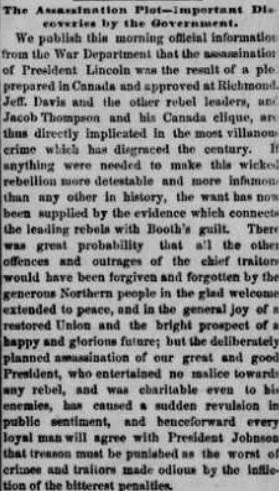
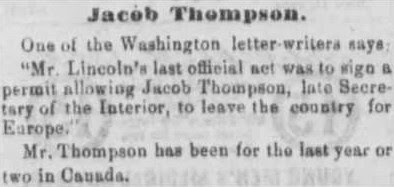
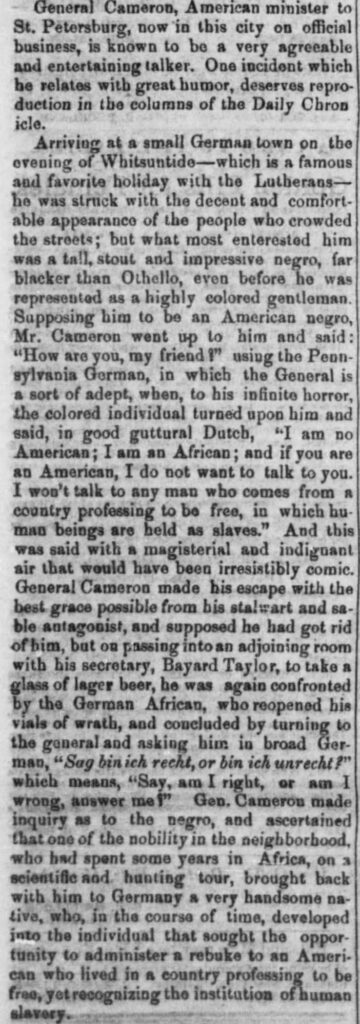
 WHAT ABOUT YOUR DESCENDANTS KNOWING ABOUT YOUR ANCESTORS?
WHAT ABOUT YOUR DESCENDANTS KNOWING ABOUT YOUR ANCESTORS?
Reach out to Dancestors Genealogy. Our genealogists will research, discover, and preserve your family history. No one is getting any younger, and stories disappear from memory every year and eventually from our potential ability to find them. Genealogist.
Preserve your legacy, and the heritage of your ancestors.
Paper gets thrown in the trash; books survive!
So please do not hesitate and call me @ 214-914-3598 and get your project started!
Visit our website to learn more!


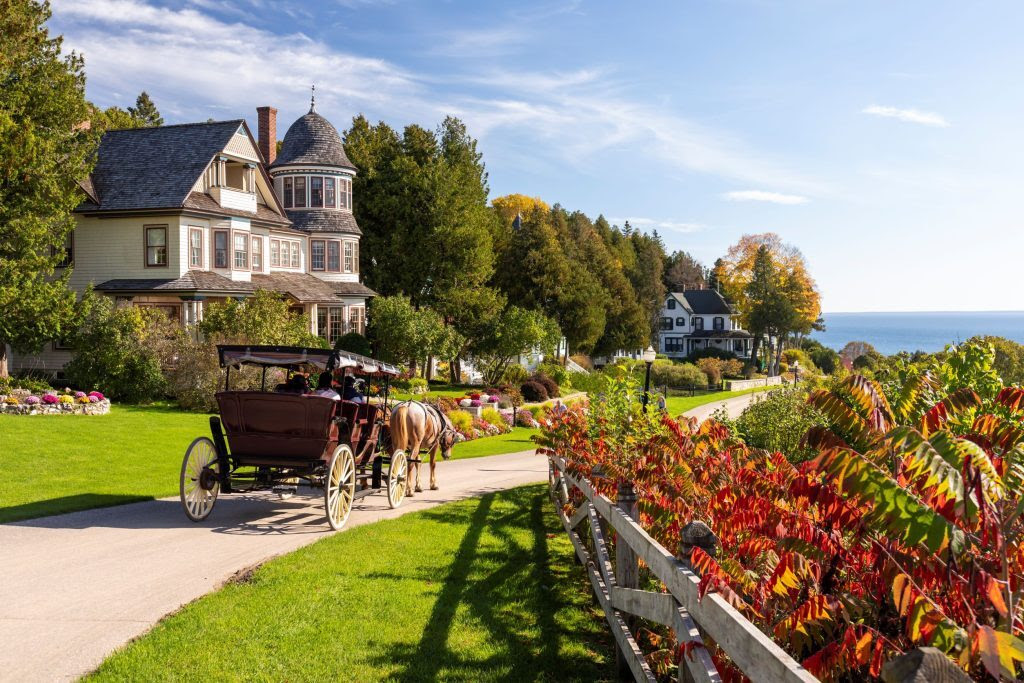 MOTORING ON MICHIGAN HIGHWAY 185 IS IMPOSSIBLE
MOTORING ON MICHIGAN HIGHWAY 185 IS IMPOSSIBLE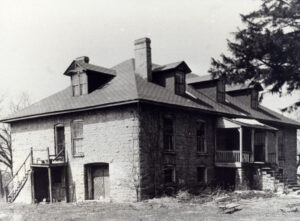 A GENEALOGIST VISITED THE SUN PARLOUR OF CANADA
A GENEALOGIST VISITED THE SUN PARLOUR OF CANADA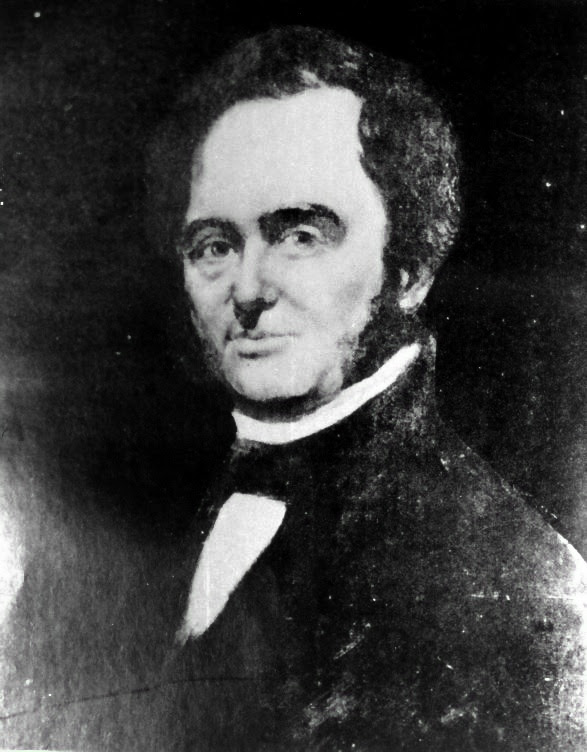 AS GENEALOGISTS WOULD SAY “THE FATHER OF THE FATHER OF TEXAS”, LEAD KING, AND BUSINESS FAILURE
AS GENEALOGISTS WOULD SAY “THE FATHER OF THE FATHER OF TEXAS”, LEAD KING, AND BUSINESS FAILURE THE NOT SO NATIVE AMERICANS
THE NOT SO NATIVE AMERICANS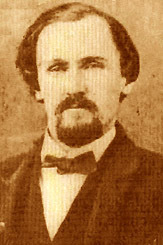 GENEALOGISTS EXPLORE CONFEDERATES ON THE GREAT LAKES
GENEALOGISTS EXPLORE CONFEDERATES ON THE GREAT LAKES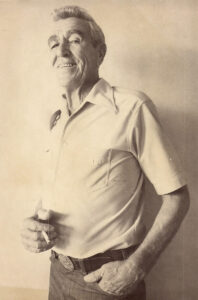 WHAT ABOUT YOUR DESCENDANTS KNOWING ABOUT YOUR ANCESTORS?
WHAT ABOUT YOUR DESCENDANTS KNOWING ABOUT YOUR ANCESTORS?